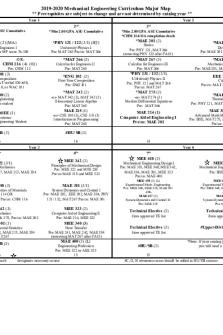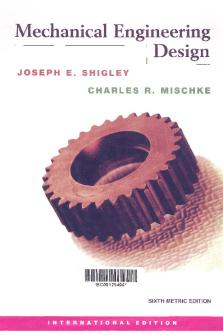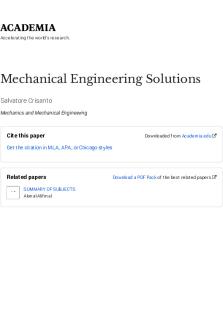Mechanical engineering lab report PDF

| Title | Mechanical engineering lab report |
|---|---|
| Author | Elliott Box |
| Course | Design Report |
| Institution | Northumbria University |
| Pages | 18 |
| File Size | 940.4 KB |
| File Type | |
| Total Downloads | 54 |
| Total Views | 164 |
Summary
N/a...
Description
Module - Engineering Systems KB4000
Contents Page: Pages 3-4
Introduction
Pages 5-6
Mechanics
Pages 7-8
Equipment
Pages 8-12 Results Pages 13-15 Discussion Page 16
Conclusion
Page 17
Health and Safety Assessment
Page 18
References
2
Introduction: The purpose of this laboratory report is to explain in detail the experiment that was preformed, firstly I carry out an experiment in which I have investigated the behaviour and measured the shear stiffness of three standard specimens subject to torque from zero degrees to failure. The three different materials that were in the experiment are as follows; 1. 0.1% Carbon Steel 2. Half- Hard Brass (60% copper and 40% Zinc) 3. 0.4% Carbon Steel
Why perform a Torsion test: Understanding torsion and where it can occur is essential in infrastructure and automotive design. A common example of torsion in engineering is when a transmission drive shaft receives a turning force from its power source. Many products and components are subjected to torsional forces during their operation. Products such as biomedical catheter tubing, switches, fasteners, and automotive steering columns are just a few devices subject to such torsional stresses. By testing these products in torsion, manufacturers are able to simulate real life service conditions, check product quality, verify designs, and ensure proper manufacturing techniques. What is torsion; Torsion is a twisting motion where different parts of an object undergo different angular displacements referred to as the angle of twist about the rotational axis. This will happen once a torque is applied.
Types of Torsion: Torsion tests can be performed by applying only a rotational motion or by applying both axial (tension or compression) and torsional forces. Types of torsion testing vary from product to product but can usually be classified as failure, proof, or product operation testing.
3
Torsion Only: applying only torsional loads to the test specimen. Axial-Torsion: applying both axial (tension or compression) and torsional forces to the test specimen. Failure Testing: twisting the product, component, or specimen until failure. Failure can be classified as either a physical break or a kink/defect in the specimen. Proof Testing: applying a torsional load and holding this torque load for a fixed amount of time.
4
Operational Testing: Testing complete assemblies or products such as bottle caps, switches, dial pens, or steering columns to verify that the product performs as expected under torsion loads
Mechanics: When there is a solid bar as seen from the examples on the previous page, for a solid beam with a circular section, when the beam is subjected to torque symbolized by “T” the shear stress and the angle of which it is twisted can be calculated by the following equations. The units are (N/MM^2). T max = Tr/Ip Where: T max = Max Torque Tr = Max shear stress Ip = Polar moment of interia ( Radius)
To calculate the polar moment of inertia of a solid circular cross section is as follows. The polar moment can be indicated as “Iz” as well as “Ip” in some instances. The units are (mm^4).
We can calculate the polar moments of inertia of a hollow beam if needed by the following equation.
Where; D4 = outside diameter of beam d4 =internal diameter of beam
5
When a circular cross section, the polar moment of inertia “Ip” can be determined using an area element in the form of the differential ring having a thickness “dp” and circumference “2 π p”. For this beam, dA = “2 π dp”.
T/Ip = Ga/L Where; T = Torque (Nmm) G = Shear modulus of elasticity of the material (N/mm^2) r = radius of cross- section (mm) d = diameter of cross- section (mm) a = angle of twist (radians)
6
Equipment: 1. Put required PPE on before starting (safety boots, goggles and lab coat). 2. Take required measurements which are the gauge length and diameter of the specimen and record. 3. Draw a line along the length of the specimen with a marker pen; this will help with observing the behaviour of the specimen. 4. Mount the specimen in the hexagonal drive socket. 5. Place the clear guard over the machine to cover the specimen to eliminate risk of injury. 6. Switch the software on and introduce the diameter and the gauge length of the specimen. 7. Begin to turn the wheel and start the test, try to turn at a constant rate to maintain a constant velocity. 8. There should be two digital displays which will measure the torque and angle of twist; this will be shown in real time. 9. These reads of the torque and angle of twist then will be recorded in your lab book. 10. Once the experiment is finished examine the fractures and record their appearance.
In this case you would need to measure the length and diameter of the specimen with a vernier calliper as shown for the image below.
Results: for 0.4% carbon steel Torque (Nm) 0 9.19 10.31 10.89 11.59 12.18 12.53 13.18 13.61 14.08 14.48 15.00 15.40 15.86 16.19 16.52 16.86 17.10 17.30 17.70 18.50 8
Angle of twist (degrees) 0 24.47 117.19 137.53 166.67 197.35 217.90 251.69 288.87 324.87 363.08 412.19 461.14 517.92 579.18 627.91 689.17 737.82 794.06 853.57 1133.97
19.17 19.39 19.58 20.03 20.19 20.38 20.60 20.78 21.05 21.20 21.45
1375.01 1526.95 1620.42 1811.22 1936.82 2062.07 2199.55 2358.58 2548.31 2733.76 2907.91 3500
3000
2500
angle of twist
2000 Torque (Nm) Angle of twist (degrees)
1500
1000
500
0
9
0 .31 .59 .53 .61 .48 .4 .19 .86 .3 .5 .39 .03 .38 .78 .2 7 8 1 5 10 11 12 13 14 1 16 16 1 1 19 20 20 20 2
0.4% Carbon Steel Diameter = 6.02mm Gauge Length = 73.12mm Max Torque = 27.50 Nm Max Twist Angle = 3804.62 °
Polar Moments of inertia = Ip = πD^4 /32 Ip = π6.02 ^4 / 32 = 128.93mm^4 27.50 Nm x 1000 = 27500Nmm Tmax X R /Ip 27500 x (6.02 / 2) / 128.93 = 642.01 Mpa G, the modulus of rigidity of 0.4% carbon steel G= (T/a) x (L/Ip) Te =9.92
e = 0.12950 radians
(9.92 / 0.12950) x (73.12 /128.93) = 43.44 Mpa
This image below is what the 0.4% carbon steel should look like before the test begins as it has not been subject to any rotational torque.
10
0.1% Carbon Steel Diameter = 5.99mm Gauge Length = 74.61mm Max Torque = 20.52Nm Max Twist Angle = 3292.57 °
Polar moments of inertia = Ip = πD^4 /32 Ip = π5.99 ^4 / 32 = 128.93mm^4 20.52 Nm x 1000 = 20520Nmm Tmax X R /Ip 20520 x (5.99 / 2) / 126.38 = 486.29Mpa G, the modulus of rigidity of 0.4% carbon steel G= (T/a) x (L/Ip) Te =6.11
e = 0.07662 radians
(6.11/ 0.07662) x (74.61 /126.38) = 47.07 Mpa
11
Brass Max stress: Diameter = 6.27mm Gauge Length = 73.5mm Max Torque = 16.7Nm Max Twist Angle = 1166 °
Polar moments of inertia = Ip = π D^4 /32 Ip = π6.27 ^4 / 32 = 7 16.7 Nm x 1000 = 16700Nmm Tmax X R /Ip 16700x (6.27 / 2) / 151.72= 345.07Mpa G, the modulus of rigidity of 0.4% carbon steel G= (T/a) x (L/Ip) Te =5.11Nm
e = 0.13893 radians
(5.11/ 0.13893) x (73.5 /151.73) = 17.81 Mpa
12
Discussion: Throughout the experiment and the testing of the three specimens the conditions for which it was carried out it remained constant. The noise levels throughout the test remained the same, it was carried out in a quiet environment with little or no background noise. The temperature of the lab which the experiment was carried out in remained constant at a standard room temperature of 21 ℃ , it is essential that temperature is regulated in this experiment as the molecule structure may change in the three specimens which will alter the results. This would affect the amount of maximum torque each specimen could withstand. The external environment did not affect any of the readings or apparatus, due to no doors or windows being open during the experiment. As the environment was controlled it will not have affected the results which were recorded during the experiment. To make the experiment more accurate as well there should have been more the three of each specimen tested to get a better average. A risk assessment was carried out before starting the experiment to fit in with health and safety regulations, this is visible on page seventeen. Other factors such as human error and error of equipment may have affected the results making them slightly inaccurate. An error which may have had a slight effect on the results could have been human error when measuring the diameter and gauge length of each specimen. Human error could be to blame with an inaccurate reading from the angle of twist or maximum amount of toque exerted. There are more factors to make this experiment more accurate such as having a machine to exert the toque on the handle as this will deliver a more constant velocity. The measurements and results which were recorded in the experiment show strongly a relationship between the shear stiffness and type of material for the amount for torque in which each specimen can with stand. The results given by torsion of a beam shows the relationship with molecule structure of a certain material and the thickness, Information which would be assumed that the thicker the material the higher the torque with different materials such as carbon steel and brass which were tested, but the experiment shows it is defined by the carbon content and the molecule structure. Adding carbon to iron to make steel does make it stronger and tougher, up to a point. Then it will get stronger but less tough. Carbon strengthens steel by distorting its crystal lattice. Low carbon and medium carbon specimens have been tested in this experiment as there between 0.1% and 0.4% carbon. Low carbon also known as mild steel, it is a low-cost material that is easy to shape. While not as hard as higher-carbon steels, carburizing can increase its surface hardness. Medium Carbon Steel Composition of 0.29%0.54% carbon, with 0.60%-1.65% manganese.
13
Molecule Structures 0.1% carbon Steel Low carbon steel has a carbon content of between 0.05% and 0.15%. This steel is soft, ductile and easy to form into applications. This graph below shows the amount of carbon and the molecule structure depending on the process in the way it is hardened.
0.4% carbon steel This is also known as medium carbon, this steel will have ductility and strength and has good wear resistance; used for large parts, forging and automotive components. The graph below shows the relationship between carbon content and between the yield point and elongation.
14
15
Conclusion: 4000 3500 3000 2500 0.4% carbon steel 0.1% carbon steel brass
2000 1500 1000 500 0 Angle of twist (Degrees)
Torque max (Nm)
I will begin to review and conclude the experiment in this next part, as we can see from the bar chart above that the angle of twist, maximum torque and shear stiffness. The graph shows that 0.4% carbon steel has the highest angle of twist at 3804.62 ° , the second highest angle of twist was 0.1% carbon steel at 3292.57 ° . Brass failed at the lowest angle of twist which was 1166 ° . Now I will review the maximum torque, 0.4% carbon steel was exerted to the highest torque when the specimen failed. The maximum torque which has recorded was 27.5 Newton meters of torque. 0.1% carbon steel had the second highest torque of 20.52 Newton meters. Brass had the least highest torque exerted to make the specimen to fail. I believe I carried this experiment out to the highest standard with the equipment that was available to me at the time, I have explained in the discussion how I would improve the results and experiment if carried out again the future.
16
17
References http://www.technologystudent.com/equip1/vernier1.htm http://www.learneasy.info/MDME/MEMmods/MEM23061A/Torsion/Torsion.html http://www.instron.co.uk/en-gb/our-company/library/test-types/torsion-test http://www.learneasy.info/MDME/MEMmods/MEM30007A/steel/steel.html http://www.azom.com/article.aspx?ArticleID=400
18...
Similar Free PDFs

Mechanical engineering lab report
- 18 Pages

Mechanical energy lab - Lab Report
- 16 Pages

Mechanical Energy lab report
- 6 Pages

Mechanical-engineering
- 1 Pages

Mechanical engineering
- 1 Pages

ENGINEERING MATERIALS LAB REPORT
- 1 Pages

2019-2020 Mechanical Engineering
- 2 Pages

Mechanical Engineering Circuits
- 10 Pages

MECHANICAL ENGINEERING REVIEW MANUAL
- 509 Pages

Mechanical Engineering Lecture Notes
- 13 Pages

MECHANICAL ENGINEERING REVIEW MANUAL
- 509 Pages

Mechanical Engineering Elements
- 29 Pages

Mechanical engineering design
- 6 Pages

Mechanical Engineering Solutions
- 21 Pages

Mechanical Engineering Level M
- 16 Pages
Popular Institutions
- Tinajero National High School - Annex
- Politeknik Caltex Riau
- Yokohama City University
- SGT University
- University of Al-Qadisiyah
- Divine Word College of Vigan
- Techniek College Rotterdam
- Universidade de Santiago
- Universiti Teknologi MARA Cawangan Johor Kampus Pasir Gudang
- Poltekkes Kemenkes Yogyakarta
- Baguio City National High School
- Colegio san marcos
- preparatoria uno
- Centro de Bachillerato Tecnológico Industrial y de Servicios No. 107
- Dalian Maritime University
- Quang Trung Secondary School
- Colegio Tecnológico en Informática
- Corporación Regional de Educación Superior
- Grupo CEDVA
- Dar Al Uloom University
- Centro de Estudios Preuniversitarios de la Universidad Nacional de Ingeniería
- 上智大学
- Aakash International School, Nuna Majara
- San Felipe Neri Catholic School
- Kang Chiao International School - New Taipei City
- Misamis Occidental National High School
- Institución Educativa Escuela Normal Juan Ladrilleros
- Kolehiyo ng Pantukan
- Batanes State College
- Instituto Continental
- Sekolah Menengah Kejuruan Kesehatan Kaltara (Tarakan)
- Colegio de La Inmaculada Concepcion - Cebu
